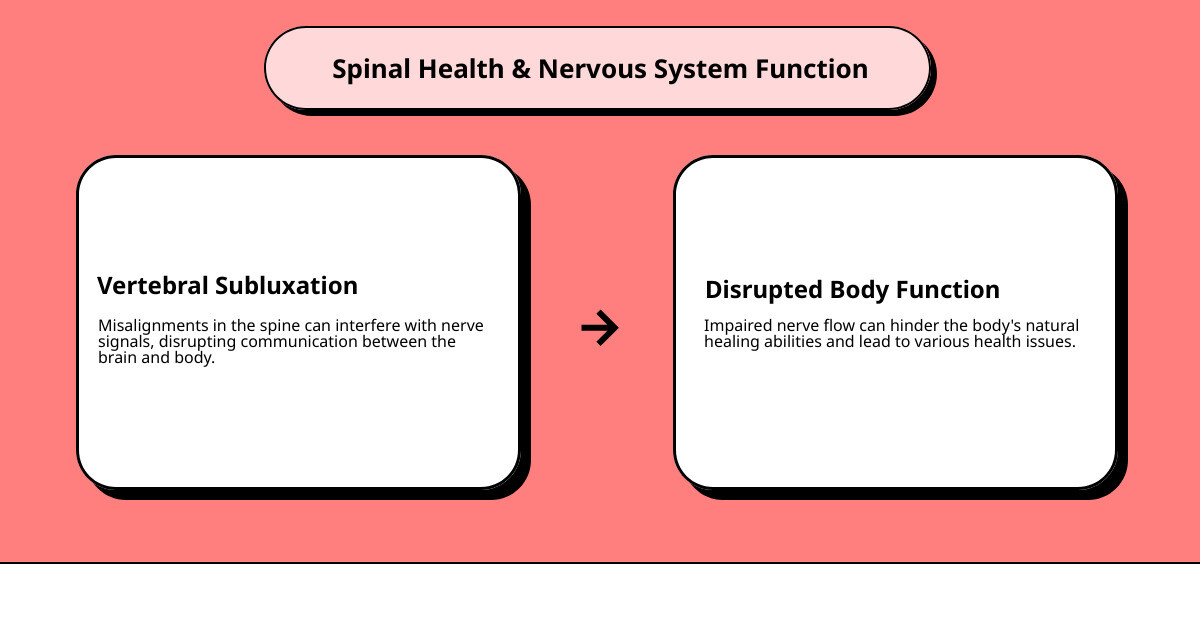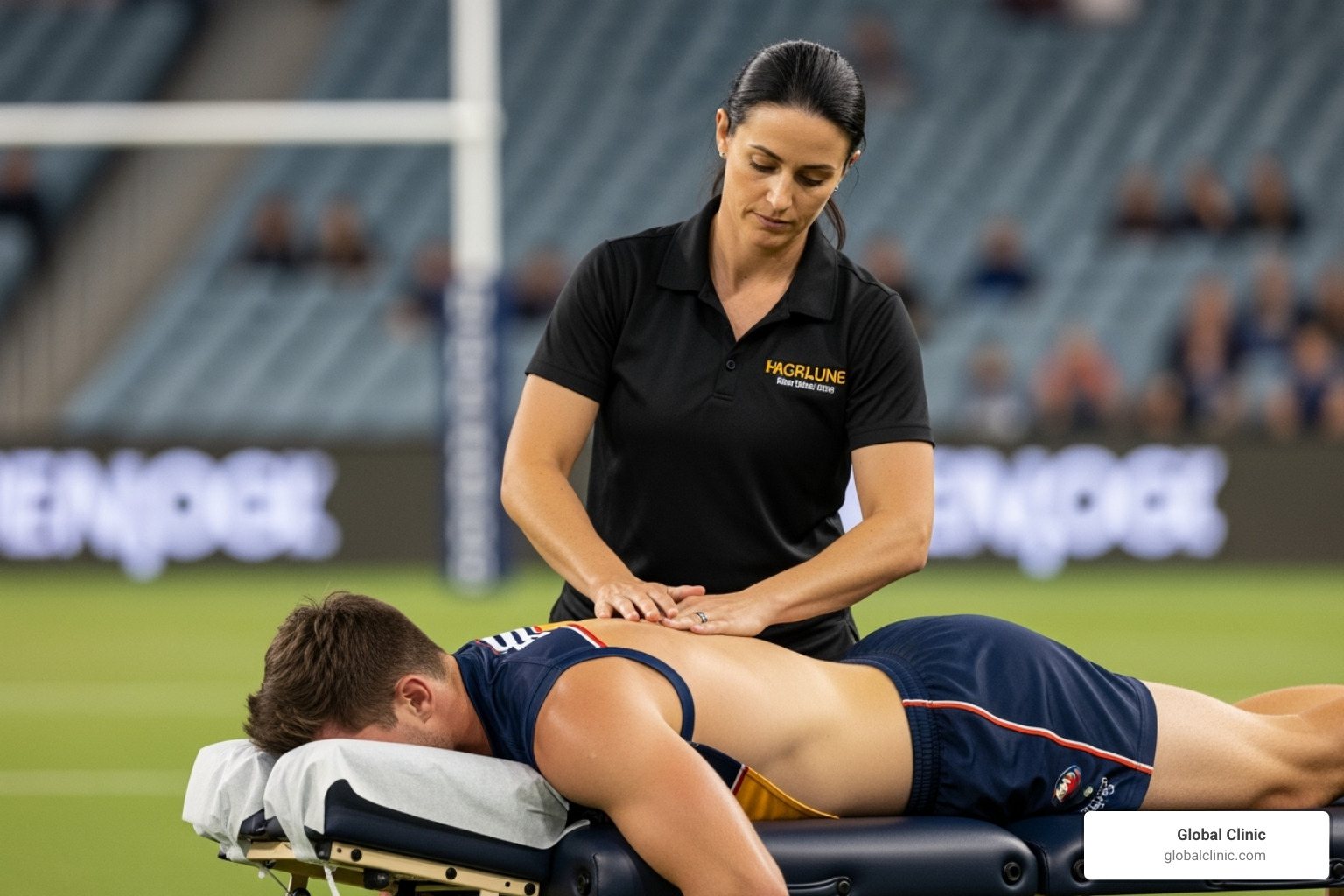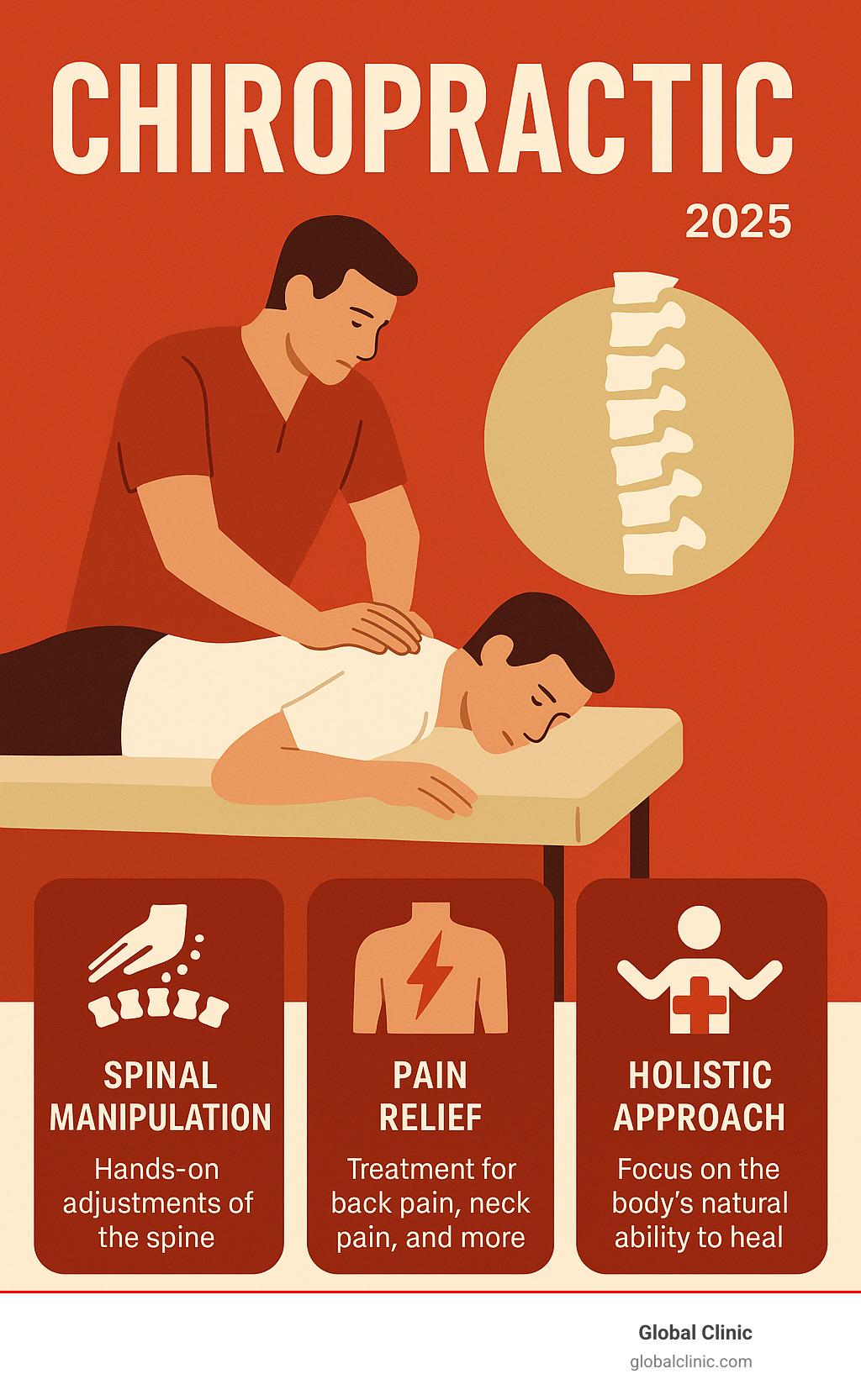Understanding Chiropractic: A Natural Path to Pain Relief
Chiropractice is a healthcare profession focused on diagnosing and treating disorders of the musculoskeletal system, especially the spine, using manual adjustments and other non-invasive techniques. It operates on the principle that proper spinal alignment allows the body’s nervous system to function optimally, promoting natural healing.
Key aspects of chiropractic care include:
- A hands-on, drug-free approach to health.
- Focus on spinal manipulation to correct misalignments (subluxations).
- Treatment for common issues like back pain, neck pain, and headaches.
Founded in 1895, chiropractic has become a leading alternative treatment in the U.S., with millions seeking care annually. The core idea is that a healthy spine supports a healthy nervous system, which is crucial for overall wellness.
At Global Clinic, we integrate chiropractic care with modern pain management to offer effective, natural relief. For over 20 years, our multidisciplinary team has helped Northern Chicago residents find lasting solutions for chronic and acute pain.

What is Chiropractic? Core Principles and History
Chiropractice is founded on the principle that the body has an incredible, innate ability to heal itself. This healing power is directly linked to the health of your spine and nervous system. The spine protects the nerve pathways that act as the body’s main communication highway between the brain and every cell. When vertebrae become misaligned—a condition called a subluxation—this communication can be disrupted, hindering the body’s natural functions.
Instead of merely masking symptoms, chiropractic care aims to correct these underlying structural issues, allowing the body to heal as it should. You can learn more about these principles at What Is Chiropractic?.
The Historical Roots of the Profession
The profession began in 1895 when Daniel David Palmer performed the first chiropractic adjustment on Harvey Lillard, a janitor who had been deaf for 17 years. After Palmer corrected a misaligned vertebra in his spine, Lillard’s hearing reportedly improved. This event sparked the development of modern chiropractic. Palmer’s son, B.J. Palmer, continued his work, establishing the Palmer School of Chiropractic in 1897 and expanding the profession’s reach.
Despite early resistance from the medical establishment, chiropractic gained significant legal and public acceptance, particularly after a 1987 antitrust lawsuit against the AMA.
The Philosophy of Chiropractic: Straights vs. Mixers
Within chiropractic, two main philosophies emerged:
- Straights: Adhering strictly to Palmer’s original theories, they focus almost exclusively on correcting vertebral subluxations to restore the body’s innate healing intelligence.
- Mixers: Representing the majority of modern chiropractors, they integrate traditional adjustments with other evidence-based treatments like exercise therapy, nutritional counseling, and physical therapy.
At Global Clinic, we accept the Mixer philosophy, combining the best of chiropractic wisdom with modern science to provide comprehensive, effective care for our Northern Chicago patients.
The Scope of Chiropractice: Conditions, Techniques, and Benefits
At Global Clinic, our holistic approach to chiropractice addresses the root cause of your health issues, not just the symptoms. We create personalized treatment plans to help you move freely and live without pain.

Common Conditions Treated
While known for treating back pain, chiropractic care is effective for a wide range of musculoskeletal conditions:
- Low Back and Neck Pain: The most common reasons for visits, often caused by posture, injury, or stress.
- Headaches and Migraines: Many headaches originate from neck issues, which can be addressed with adjustments.
- Sciatica: We treat the underlying cause of this radiating leg pain, such as a misaligned spine or bulging disc.
- Joint Pain: Adjustments can improve function and reduce pain in shoulders, hips, knees, and other joints.
- Whiplash: Gentle adjustments help restore alignment and reduce pressure on nerves after an accident.
- Other Conditions: Care can also benefit those with repetitive strain injuries, arthritis, and fibromyalgia.
We also educate patients on the importance of good posture. Learn more at Maintaining Good Posture.
Key Chiropractic Techniques
The core of chiropractice is the adjustment, where a controlled force is applied to a joint. The “popping” sound is simply gas releasing from the joint fluid. We use various techniques, including:
- High-Velocity, Low-Amplitude (HVLA) Thrust: The classic, quick adjustment.
- Mobilization: Slower, gentler movements and stretches.
- Activator Method: A handheld instrument delivers a precise, gentle impulse.
- Flexion-Distraction: A specialized table gently stretches the spine to decompress discs.
- Soft Tissue Therapy: Massage and stretching to address surrounding muscles and ligaments.
Potential Benefits of Care
Patients often experience benefits beyond pain relief, such as increased range of motion, better posture, improved athletic performance, and a reduced need for pain medication. Many report an overall sense of improved wellness, energy, and vitality.
Is Chiropractic Safe and Effective? Examining the Evidence
It’s natural to ask about the safety and effectiveness of any healthcare treatment. At Global Clinic, we prioritize your safety with a thorough initial consultation, including a medical history review, physical exam, and diagnostic imaging if needed. This ensures chiropractice is appropriate for you and allows us to explain the treatment, benefits, and any potential risks.
Scientific Evidence and Effectiveness
A growing body of research supports chiropractic care, especially for certain conditions:
- Low Back Pain: Numerous studies and healthcare guidelines recommend spinal manipulation as a safe, effective, drug-free first treatment for acute and chronic low back pain.
- Neck Pain: Research shows that adjustments can provide significant short-term improvement for mechanical neck pain, often performing as well as physical therapy.
- Headaches: Evidence is particularly strong for headaches originating from the neck (cervicogenic headaches), and many patients with tension headaches or migraines also report relief.
Studies also suggest that chiropractic care can be a cost-effective treatment for musculoskeletal issues compared to some conventional medical approaches. For more research, visit Chiropractic: In Depth.
Understanding the Risks and Side Effects
Chiropractice is generally considered very safe when performed by a licensed professional. Most side effects are mild and temporary, such as soreness, stiffness, or fatigue, usually resolving within 24-48 hours.
Serious complications are extremely rare. These can include aggravation of a disc problem or, in very rare instances, a type of stroke associated with neck manipulation. However, the risk is incredibly low, and a thorough screening process helps identify patients who may be at higher risk. At Global Clinic, your safety is our top priority, and we always discuss any individual risk factors with you before beginning treatment.
The Professional Chiropractor: Education, Licensing, and Career
A Doctor of Chiropractic (D.C.) is a highly trained healthcare professional who completes a rigorous educational and licensing process comparable to other doctoral-level programs.
Education and Licensing Requirements
The path to becoming a licensed chiropractor involves:
- Undergraduate Study: At least three years of undergraduate education, with a strong focus on sciences like biology, chemistry, and physics.
- Doctor of Chiropractic Program: A four-year program at an accredited institution, comprising at least 4,200 hours of study. The curriculum covers anatomy, physiology, diagnostics, radiology, and chiropractic techniques.
- Clinical Experience: A mandatory, supervised clinical internship where students gain hands-on experience treating patients.
- National and State Exams: Graduates must pass comprehensive national board examinations and obtain a state license to practice.
- Continuing Education: Chiropractors are required to complete ongoing education to maintain their licenses and stay current with the latest research.
You can find more details at Credentialing, Licensing, and Education.
Career Paths and Salary
Chiropractors work in a variety of settings. The field is projected to grow, driven by an aging population and greater acceptance of non-invasive pain management.
| Career Path | Description |
|---|---|
| Private Practice | Owning and operating an independent clinic. |
| Associate Position | Working in an established practice to gain experience. |
| Multidisciplinary Clinic | Collaborating with other healthcare professionals, like at Global Clinic. |
Other paths include specializing in sports medicine, working in hospitals, or pursuing research and education. According to the Bureau of Labor Statistics, the profession offers strong career prospects.
What is Chiropractic? Core Principles and History
At its core, chiropractice is a healthcare profession centered on the body’s innate healing capabilities. It emphasizes the critical relationship between the spine and the nervous system. A well-aligned spine allows for clear communication between the brain and the body, promoting optimal health.
When vertebrae are misaligned (a condition known as a subluxation), they can interfere with nerve signals, potentially leading to pain and dysfunction. The goal of chiropractic is to correct these misalignments, treating the root cause of health issues rather than just the symptoms. For more on this approach, see What Is Chiropractic?.
The Historical Roots of the Profession
Chiropractice was founded in 1895 by Daniel David Palmer, who performed the first adjustment on a janitor and reportedly restored his hearing. This event launched a new philosophy of health focused on spinal alignment. His son, B.J. Palmer, was instrumental in developing the profession and establishing the Palmer School of Chiropractic. Despite early opposition, the profession grew and gained mainstream acceptance, especially after a landmark 1987 legal victory against the AMA.
The Philosophy of Chiropractic: Straights vs. Mixers
The profession includes two main philosophical camps:
- “Straights” adhere to the original focus on correcting subluxations as the key to all health.
- “Mixers,” who make up the majority today, integrate chiropractic adjustments with other modern treatments like physical therapy and nutritional advice.
At Global Clinic, we follow the “Mixer” philosophy, providing evidence-based, multidisciplinary care to achieve the best outcomes for our patients.
The Scope of Chiropractice: Conditions, Techniques, and Benefits
At Global Clinic, we offer a holistic approach to health, focusing on pain management and improved function. Our goal is to address the underlying causes of your discomfort so you can enjoy a better quality of life.
Common Conditions Treated
Chiropractice is effective for a wide range of musculoskeletal issues, including:
- Low Back Pain: A primary reason patients seek care, with spinal manipulation being a recommended first-line treatment.
- Neck Pain: Often resulting from poor posture or injury, it responds well to adjustments.
- Headaches and Migraines: Many headaches originate in the neck and can be relieved by addressing spinal misalignments.
- Sciatica: We work to relieve pressure on the sciatic nerve to reduce radiating leg pain.
- Joint Pain: Care extends beyond the spine to shoulders, hips, knees, and other joints.
- Other Issues: We also help manage conditions like whiplash, repetitive strain injuries, arthritis, and fibromyalgia.
For tips on prevention, see Maintaining Good Posture.
Key Chiropractic Techniques
The chiropractic adjustment is a cornerstone of treatment, involving a controlled force applied to a joint to restore motion. The “cracking” sound is a normal release of gas from the joint. Techniques include:
- High-Velocity, Low-Amplitude (HVLA) Thrust: The classic, precise adjustment.
- Mobilization: Gentler, slower movements to increase flexibility.
- Activator Method: A tool-assisted, low-force technique.
- Flexion-Distraction & Drop-Table: Specialized tables assist in decompressing the spine and performing adjustments.
- Soft Tissue Therapy: Addresses related muscles and ligaments through massage and stretching.
Potential Benefits of Care
Patients often report significant pain reduction, increased range of motion, better posture, and less reliance on medication. Many also experience improved athletic performance, headache relief, and an overall boost in energy and well-being.
Is Chiropractic Safe and Effective? Examining the Evidence
Patient safety and treatment effectiveness are our top priorities. Before beginning care, we conduct a comprehensive assessment, including a medical history and physical exam, to ensure chiropractice is appropriate for you. We believe in informed consent, so we always discuss the proposed treatment plan, benefits, and any potential risks.
Scientific Evidence and Effectiveness
The scientific support for chiropractice is strong, particularly for musculoskeletal conditions.
- Low Back Pain: Clinical guidelines recommend spinal manipulation as a safe and effective initial treatment for both acute and chronic low back pain. Studies also show it can be a cost-effective option.
- Neck Pain: Research indicates that adjustments can provide short-term relief for mechanical neck pain and can be as effective as other common therapies.
- Headaches: There is good evidence supporting chiropractic care for headaches that originate in the neck (cervicogenic headaches).
For more detailed research, you can visit Chiropractic: In Depth.
Understanding the Risks and Side Effects
According to the World Health Organization, chiropractic care is generally safe when performed skillfully.
Common Side Effects: Most side effects are mild and temporary, lasting no more than a day or two. They may include soreness, stiffness, or fatigue, similar to post-exercise sensations.
Rare Risks: Serious complications are extremely rare. These include the potential aggravation of a disc herniation or a very small risk of stroke associated with neck adjustments. A thorough screening by a qualified chiropractor is the best way to minimize these risks. We always prioritize your safety and will not proceed with treatment if there are any contraindications.
The Professional Chiropractor: Education, Licensing, and Career
Doctors of Chiropractic (D.C.s) are highly educated healthcare professionals who undergo demanding academic and clinical training to earn their title and license.
Education and Licensing Requirements
The journey to becoming a chiropractor is rigorous:
- Prerequisites: An undergraduate background with a strong emphasis on science is required before entering a D.C. program.
- Doctoral Program: A four-year postgraduate program accredited by the Council on Chiropractic Education (CCE), involving at least 4,200 hours of study in basic sciences, clinical sciences, and chiropractic principles.
- Clinical Training: A mandatory internship provides extensive hands-on patient care experience.
- Licensure: Graduates must pass national board exams and obtain a state license, which requires ongoing continuing education to maintain.
For more on these standards, see Credentialing, Licensing, and Education.
Career Paths and Salary
Chiropractors have diverse career options, from owning a private practice to working in multidisciplinary clinics, hospitals, or corporate wellness programs. Many specialize in areas like sports medicine, serving athletes at all levels. The VA system has also significantly increased its use of chiropractic care.
The career outlook is positive, with expected growth in the field. Salary varies by location and practice type, but the profession is often described as highly rewarding. For more details, see the Chiropractors (Bureau of Labor Statistics).

Frequently Asked Questions about Chiropractic Care
We understand you may have questions about chiropractice. Here are answers to some common inquiries we receive at Global Clinic.
What does a chiropractic adjustment feel like?
Most patients find adjustments comfortable and relaxing. You will feel a quick, controlled movement at a specific joint. The “popping” or “cracking” sound you might hear is called cavitation—a normal release of gas bubbles from the joint fluid, similar to cracking your knuckles. It is not a sign of damage. Afterward, you may feel immediate relief, though some experience mild, temporary soreness, like after a workout, which usually fades within 24 hours.
How many sessions will I need?
The number of sessions depends on your specific condition, its severity, and your health goals. Acute issues, like a recent injury, may resolve in just a few visits. Chronic conditions that have developed over a long period will likely require a more extended treatment plan. During your initial consultation, we will create a personalized plan and discuss the expected timeline for your care.
Is chiropractic care covered by insurance?
Yes, chiropractice is covered by most major insurance plans, including Medicare and Medicaid. However, coverage details like co-pays, deductibles, and the number of covered visits vary significantly between plans. We recommend contacting your insurance provider directly to understand your specific benefits before your first visit. Our team at Global Clinic is experienced in working with insurance companies and can help you steer your coverage.
Conclusion
Chiropractice is a healthcare profession dedicated to the principle that the body can heal itself when the spine and nervous system are functioning correctly. From its origins in 1895 to its modern, evidence-based practice, it has proven to be a safe and effective solution for many, especially for conditions like low back pain, neck pain, and headaches. The focus is on treating the root cause of pain, not just the symptoms.
At Global Clinic, we have proudly served the Northern Chicago community for over 20 years, including residents of Arlington Heights, Palatine, Schaumburg, Northbrook, and surrounding areas. We are passionate about providing personalized, innovative care that combines chiropractice with physical therapy and regenerative medicine. Our goal is to offer affordable, effective solutions to help you move freely and live a healthier life.
If you are ready to explore a natural path to better health, our team is here to help you take the first step.
More info about our chiropractic services




